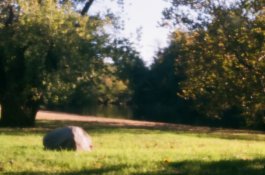mcfitz
Member
- Joined
- Nov 9, 2006
- Messages
- 144
- Format
- Multi Format
I've been turning 35mm film cannisters into pinhole cameras lately, and after a certain amount of trial, error and limited success, have at last worked out the problems that were encountered. The pinholes are home made, and are about f130. In order to use a tripod, I've taped small, extra strong magnets inside the cannisters, and there is a corresponding magnet taped to the outside, on the bottom. A small metal L bracket is bolted to one of my tripod quick release plates, and with the magnets, the cannister-cameras are quite stable on that. The lens caps are also made from film cannisters, cut to size and cut open, so they slip over the pinhole and can be slipped aside for the exposure.
I cut 7.5cm strips of 35mm film to load in the cameras, and that length is just short of the circumference of the cannisters. As a result, the effects are unexpected, like distorted panoramic images. Which I really like!
Here are some of the results. The building is the Natural History Museum, the facade, and under its arcades.




I cut 7.5cm strips of 35mm film to load in the cameras, and that length is just short of the circumference of the cannisters. As a result, the effects are unexpected, like distorted panoramic images. Which I really like!
Here are some of the results. The building is the Natural History Museum, the facade, and under its arcades.























